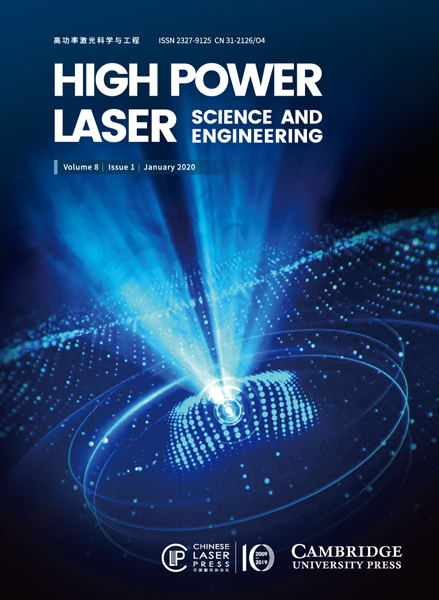2013, 1(3-4) Column
High Power Laser Science and Engineering 第1卷 第3-4期
A method for inertial confinement fusion driven by powerful long wavelength electromagnetic pulses (EMPs), such as ${\rm CO}_{2}$ laser pulses or high power microwave pulses, is proposed. Due to the high efficiency of generating such long wavelength electromagnetic pulses, this method is especially important for the future fusion electricity power Special fuel targets are designed to overcome the shortcomings of the long wavelength electromagnetic pulses.
CO2 laser Inertial confinement fusion laser acceleration The process of high power laser interaction with the large scale length corona plasma produced by the leading edge of the laser pulse has been investigated. Early experimental results are re-analyzed and conclusions drawn. In particular, studies of the close connection of unstable filamentation instability with – mainly – two-plasmon decay and – partly – stimulated Raman scattering, stimulated Brillouin scattering, and resonance absorption are carried out in this paper. The positive and negative effects of filamentation instability are also discussed.
We demonstrate a monolithic single frequency Tm-doped fiber amplifier with output power of 51.5 W. A single frequency fiber laser at 1.97 $\mathrm {\mu} $ m is amplified by a cascaded master oscillator power amplifier (MOPA) system with all-fiber configuration. The optical-to-optical conversion efficiency of the main fiber amplifier is 45%. No amplified spontaneous emission (ASE) or stimulated Brillouin scattering (SBS) effect is observed in the fiber amplifier. The output power could be further scaled by launching more pump power.
Single frequency Tm-doped fiber laser fiber MOPA monolithic configuration. An energy measurement system in a Large-aperture high power laser experiment platform is introduced. The entire measurement system includes five calorimeters, which carry out the energy measurement of the fundamental frequency before the frequency conversion unit, remaining fundamental frequency, remain second-harmonics, third harmonics, as well as the energy balance measurement after the frequency conversion unit. Combinational indirect calibration and direct calibration are employed to calibrate the sampling coefficients of the calorimeters. The analysis of the data showed that, regarding the energy balance coefficients, combinational calibration approach gives a higher precision, and leads to an energy balance with 1%; and regarding the energy sampling coefficients for the various wavelengths after the frequency conversion, the results from direct and combinational calibration are consistent. The uncertainties for all energy sampling coefficients are within 3%, which guarantees the reliability of the energy measurement for the laser facility.
Laser diagnostics pulse energy calorimeter high power laser The intensity distributions of a high-power broadband laser beam passing through a nonlinear optical medium with defects and then propagating in free space are investigated based on the general nonlinear Schr?dinger equation and the split-step Fourier numerical method. The influences of the bandwidth of the laser beam, the thickness of the medium, and the defects on the light intensity distribution are revealed. We find that the nonlinear optical effect can be suppressed and that the uniformity of the beam can be improved for a high-power broadband laser beam with appropriate wide bandwidth. It is also found that, under the same incident light intensity, a thicker medium will lead to a stronger self-focusing intensity, and that the influence of defects in the optical elements on the intensity is stronger for a narrowband beam than for a broadband beam.
broadband laser beam defects nonlinear medium self-focusing Recent progress on rare-earth doped polycrystalline YAG transparent ceramics has made them an alternative novel solid-state laser gain material. In this paper we present results of our research on polycrystalline RE:YAG transparent ceramics. High optical quality YAG ceramics doped with various rare-earth (RE) ions such as ${\rm Nd}^{3+}$ , ${\rm Yb}^{3+}$ , ${\rm Er}^{3+}$ , ${\rm Tm}^{3+}$ , and ${\rm Ho}^{3+}$ have been successfully fabricated using the solid-state reactive sintering method. Highly efficient laser oscillations of the fabricated ceramics are demonstrated.
RE:YAG Solid State Lasers Transparent Ceramics 动态信息
动态信息 丨 2023-06-21
HPL Highlight (Vol. 11, e40): NIF仍然是全球唯一一个能够进行ICF点火实验的装置动态信息 丨 2023-06-21
HPL Highlight (Vol. 11, e9): 变分神经网络预测激光尾波场加速电子能谱动态信息 丨 2023-06-21
HPL Highlight (Vol. 11, e7): 目标探测网络加入,激光等离子体加速器实现实时诊断动态信息 丨 2023-06-21
HPL Highlight (Vol. 11, e5): 910 nm波段超宽带种子源,向100 PW超强超短激光进发动态信息 丨 2023-06-21
HPL Highlight (Vol. 11, e4): 100 PW单束压缩!多步压缩器进阶双光栅激光评论微信公众号

点击菜单“联系编辑”即可添加期刊编辑为好友啦




